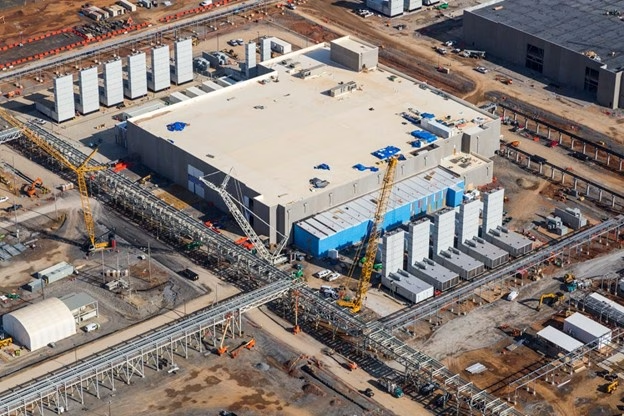As global demand for data processing and storage accelerates, the traditional approach to building data centers is evolving. Enter modular data center construction—a method that offers faster deployment, easier scalability, and better cost control. In an industry where time-to-market and operational efficiency are critical, modular designs are increasingly becoming the go-to solution for both hyperscale developers and enterprise clients.
What Is a Modular Data Center?
A modular data center is built using prefabricated modules or components that are manufactured off-site and assembled quickly on location. These modules can include power units, cooling systems, server rooms, and security infrastructure. Each module is designed to integrate seamlessly into the broader data center ecosystem, allowing for a plug-and-play style of deployment.
This approach contrasts with traditional data center construction, which is typically site-built from the ground up over months—or even years—of planning and construction. Modular systems significantly reduce that timeline.
Speed: Cutting Build Time Dramatically
One of the most attractive features of modular data centers is speed. Because much of the infrastructure is pre-engineered and built in parallel with site preparation, deployment can take just a few months instead of a year or more.
For cloud providers and content delivery networks, this means faster go-live dates and the ability to respond quickly to shifting market needs. In regions experiencing sudden spikes in digital demand—such as emerging markets or cities adding 5G coverage—modular solutions allow companies to scale infrastructure rapidly.
Scalability: Grow As You Go
Traditional data centers often require massive up-front investments and fixed capacity planning. With modular systems, operators can start small and expand incrementally as demand increases.
This is especially important in edge computing, where smaller-scale facilities are needed closer to end users to reduce latency. A company can deploy a single module at an edge location and then add additional modules as traffic grows, avoiding overbuilding and optimizing operational costs.
Even the world’s first underwater data center to be located in Shanghai’s Lin-gang Special Area and powered entirely by offshore wind energy will host modular computing units cooled directly by seawater.
Cost Advantages and Predictability
Prefabricated modules offer greater cost predictability. Because components are standardized and produced in a controlled factory environment, there is less room for delays, budget overruns, or design inconsistencies.
Additionally, modular builds often require fewer workers on-site and shorter construction timelines, leading to reduced labor costs and permitting expenses. Standardized builds can also reduce maintenance complexity and downtime, translating into long-term operational savings.
A Fit for Sustainability Goals
Many modular data centers are designed with energy efficiency in mind. Integrated cooling systems, renewable-ready power modules, and optimized airflow design all contribute to a reduced carbon footprint. Some modular builds are even designed to be relocated or repurposed, offering flexibility that aligns with circular economy principles.
The Road Ahead
Modular construction is no longer a niche strategy—it’s quickly becoming a standard in modern data center development. Whether supporting a hyperscale provider expanding globally or a telecom company building edge infrastructure, the modular approach delivers unmatched flexibility, speed, and cost-effectiveness. As digital demand continues to climb, modular data centers will play a central role in building the internet’s physical backbone.
Examples of modular data centers currently under construction:
Meta’s Jeffersonville, Indiana Facility
In January 2024, Meta broke ground on a nearly 700,000‑square‑foot data center in Jeffersonville, Indiana, which is being assembled using prefabricated modular components. Each module—complete with power, cooling, and IT racks—is manufactured off‑site and “plugged in” on location, dramatically reducing construction time and complexity.
K2 Strategic’s Johor, Malaysia Campus
Singapore‑based K2 Strategic deployed two 40 MW modular buildings in Johor, Malaysia, using a fully containerized design. Each module arrived as a self‑contained unit—complete with chilled‑water cooling, power distribution, and server racks—and was commissioned on site in just nine months, earning the project DCD’s 2025 Editor’s Choice Award for its speed and technical ingenuity.
Eviden’s Jupiter Exascale Data Center in Jülich, Germany
To host Europe’s first exascale supercomputer, Eviden is erecting a turnkey modular data center built from around 50 pre‑built modules. These include 20 IT container units, 15 power‑feed containers, and 10 logistics modules, all integrated into a single 2,300 m² facility—allowing rapid on‑site assembly and future scalability.
Meta’s Cheyenne, Wyoming Build
Also part of Meta’s 2025 rollout, the Cheyenne, Wyoming campus (over 700,000 sq ft) is using modular assemblies to streamline construction and ensure consistent quality across power, cooling, and server halls. The project, by Fortis Construction, is expected to be operational in 2026.
Each of these projects demonstrates how modular construction—whether via fully containerized modules or factory‑built structural units—can slash deployment timelines, improve cost predictability, and simplify future expansions.

